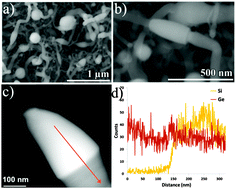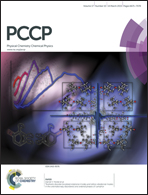Synthesis of silicon–germanium axial nanowire heterostructures in a solvent vapor growth system using indium and tin catalysts†
Abstract
Here we describe a relatively facile synthetic protocol for the formation of Si–Ge and Si–Ge–Si1−xGex axial nanowire heterostructures. The wires are grown directly on substrates with an evaporated catalytic layer placed in the vapour zone of a high boiling point solvent with the silicon and germanium precursors injected as liquids sequentially. We show that these heterostructures can be formed using either indium or tin as the catalyst seeds which form in situ during the thermal anneal. There is a direct correlation between growth time and segment length allowing good control over the wire composition. The formation of axial heterostructures of Si–Ge–Si1−xGex nanowires using a triple injection is further discussed with the alloyed Si1−xGex third component formed due to residual Ge precursor and its greater reactivity in comparison to silicon. It was found that the degree of tapering at each hetero-interface varied with both the catalyst type and composition of the NW. The report shows the versatility of the solvent vapour growth system for the formation of complex Si–Ge NW heterostructures.


 Please wait while we load your content...
Please wait while we load your content...